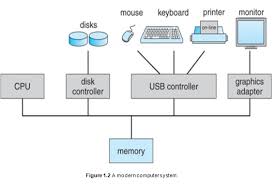In the realm of modern computer systems, the I/O (Input/Output) controller plays a pivotal role in facilitating communication between the computer’s central processing unit (CPU) and its peripheral devices. I/O controllers are essential components that ensure the smooth and efficient operation of various input and output operations, from keyboards and mice to printers and storage devices. Understanding the role of I/O controllers can provide insight into how computer systems manage data transfer and interact with external hardware.
1. What is an I/O Controller?
An I/O controller is a specialised hardware component responsible for managing data exchange between the CPU and peripheral devices. It acts as an intermediary that processes and directs the flow of data to and from various I/O devices, ensuring that information is accurately and efficiently transferred.
- Function: The I/O controller receives commands from the CPU and translates them into signals that peripheral devices can understand. It also handles incoming data from these devices, converting it into a format that the CPU can process.
- Types: I/O controllers come in various forms, including integrated circuits on motherboard chipsets, standalone peripheral controller cards, and specialised modules within larger systems.
2. The Importance of I/O Controllers in Modern Systems
I/O controllers are critical to the functioning of modern computer systems for several reasons:
- Efficient Data Transfer: I/O controllers manage the flow of data between the CPU and peripheral devices, ensuring that data is transferred efficiently and accurately. This efficiency is crucial for maintaining system performance and responsiveness.
- Device Management: They handle the management of multiple devices connected to the computer, such as USB devices, hard drives, and network interfaces. By coordinating these devices, I/O controllers prevent conflicts and ensure smooth operation.
- Error Handling: I/O controllers are equipped to handle errors that may occur during data transfer. They can detect and correct errors, ensuring data integrity and preventing system crashes or data corruption.
3. Key Features of Modern I/O Controllers
Modern I/O controllers are equipped with several advanced features that enhance their functionality and performance:
- Multiplexing: Many I/O controllers support multiplexing, which allows them to manage multiple I/O channels simultaneously. This capability improves the efficiency of data handling and reduces the time required for data transfer.
- DMA Support: Direct Memory Access (DMA) support is a common feature in modern I/O controllers. DMA allows peripheral devices to transfer data directly to and from memory without involving the CPU, freeing up processing power and improving overall system performance.
- Interrupt Handling: I/O controllers use interrupt handling to manage communication between the CPU and peripheral devices. When a device requires attention, it sends an interrupt signal to the CPU, which temporarily pauses its current task to address the request. This mechanism ensures timely processing of device inputs and outputs.
- Advanced Protocol Support: Modern I/O controllers support various communication protocols, such as USB, SATA, and PCIe. These protocols enable high-speed data transfer and compatibility with a wide range of peripherals.
4. The Impact of I/O Controllers on System Performance
The efficiency and performance of I/O controllers directly impact the overall performance of a computer system. Key areas of impact include:
- Speed and Responsiveness: I/O controllers affect the speed at which data is transferred between the CPU and peripheral devices. Faster controllers contribute to quicker data processing and improved system responsiveness.
- Scalability: Effective I/O controllers allow for the easy addition of new devices and expansion of system capabilities. They provide the flexibility to integrate additional peripherals without significant performance degradation.
- Reliability: Reliable I/O controllers ensure consistent performance and minimise the risk of data loss or corruption. Their error-handling capabilities contribute to the stability and reliability of the system.
5. Choosing the Right I/O Controller
Selecting the appropriate I/O controller for a computer system involves considering several factors:
- Compatibility: Ensure that the I/O controller is compatible with the computer’s motherboard and the devices you plan to connect. Compatibility with communication protocols and interfaces is essential for seamless integration.
- Performance Requirements: Assess the performance requirements of your system. High-performance applications may require advanced I/O controllers with features like DMA support and high-speed protocol compatibility.
- Future Upgrades: Consider future upgrade potential. Choosing an I/O controller that supports additional features and higher-speed interfaces can provide better scalability and longevity for your system.
Conclusion
The I/O controller is a crucial component in modern computer systems, responsible for managing the communication between the CPU and peripheral devices. Its role in ensuring efficient data transfer, device management, and error handling is essential for maintaining system performance and reliability. By understanding the features and benefits of I/O controllers, you can make informed decisions about the components that best meet your system’s needs, ensuring optimal performance and seamless integration with various peripherals.


